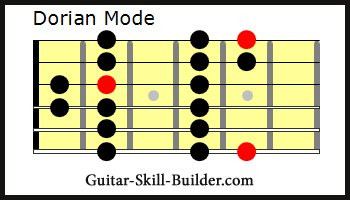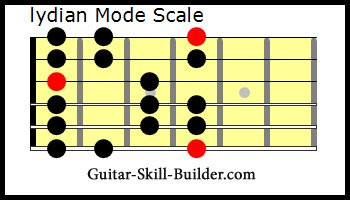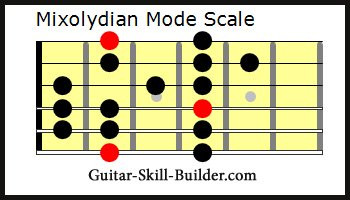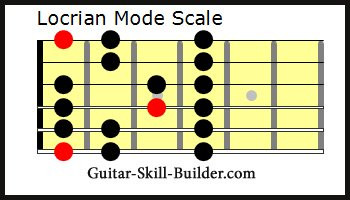Guitar modes are a fascinating area of music theory that can unlock new dimensions in your guitar playing. Derived from the major and minor scales, each mode possesses a unique character and sonic flavor, offering a spectrum of emotions from bright and uplifting to soulful and melancholic. Think of them as different shades on your musical palette, each ready to paint your guitar solos and compositions with distinct colors.
Experimenting with modes is crucial for developing your individual sound. They provide the vocabulary of musical expression, and understanding them is just the beginning of a limitless journey. Each guitar mode resonates best with specific chord types and progressions, which we will explore as we delve into each mode.
Let’s explore the seven guitar modes and how a Guitar Modes Chart can be your essential tool to master them.
The 7 Guitar Modes Explained
To truly grasp modes, visualizing them is incredibly helpful. A guitar modes chart provides this visual aid, allowing you to see the patterns and relationships between each mode. Below, we’ll introduce each of the seven modes, and for each, you’ll find a chart to help you visualize it on the fretboard.
1. Ionian Mode – The Major Scale
The Ionian mode is essentially another name for the major scale. It’s the foundational mode, characterized by its bright, happy, and uplifting sound. Think of classic major key songs – they all embody the Ionian mode.
Click on the image below to view a high-quality guitar major scale tab in full screen.
 Ionian Guitar Mode Chart
Ionian Guitar Mode Chart
2. Dorian Mode Guitar Scale – The Soulful Minor
The Dorian mode steps into a more soulful territory. It has a minor tonality but with a unique richness that sets it apart from the natural minor scale. It’s often described as melancholic yet sweet, making it perfect for blues, jazz, and even folk music.
Click on the image below to explore a high-quality guitar Dorian mode tab in full screen.
 Dorian Guitar Mode Chart
Dorian Guitar Mode Chart
3. Phrygian Mode Scale – The Spanish Flavor
The Phrygian mode immediately evokes a Spanish or exotic feeling. Its characteristic minor second interval gives it a distinct dark and dramatic sound, often used in flamenco, heavy metal, and world music.
Click on the image below to view a high-quality guitar Phrygian mode tab chart in full screen.
 Phrygian Mode Guitar Chart
Phrygian Mode Guitar Chart
4. Lydian Mode Guitar Scale – The Dreamy Major
The Lydian mode is known for its dreamy and ethereal quality. It’s a major mode, but the raised 4th degree gives it a floating, suspended sound. Think of film scores and progressive rock – Lydian mode adds a touch of magic.
Click on the image below to expand to a high-quality guitar Lydian scale mode tab.
 Lydian Mode Guitar Chart
Lydian Mode Guitar Chart
5. Mixolydian Mode Scale – The Blues and Dominant Sound
The Mixolydian mode has a distinctly bluesy and dominant character. It’s essentially a major scale with a flattened 7th, giving it a dominant 7th chord feel. This mode is a staple in blues, rock, country, and funk music.
Click on the image below to explore a high-quality guitar Mixolydian scale mode tab in full screen.
 Mixolydian Mode Guitar Chart
Mixolydian Mode Guitar Chart
6. Aeolian Mode – The Natural Minor Scale
The Aeolian mode is the same as the natural minor scale. It embodies a sad, melancholic, and often dramatic sound. It’s a fundamental mode for expressing minor key emotions in music, from pop ballads to heavy metal anthems.
Click on the image below to access a high-quality guitar Aeolian scale mode tab in full screen.
 Aeolian Natural Minor Scale Chart
Aeolian Natural Minor Scale Chart
7. Locrian Mode Guitar Scale – The Dissonant and Dark
The Locrian mode is the most dissonant and arguably the darkest of all modes. Due to its diminished triad and tritone interval, it’s less commonly used for melodic playing but can create unique and unsettling effects in specific musical contexts, such as avant-garde or extreme metal genres.
Click on the image below to view a high-quality guitar Locrian mode scale tab in full screen.
 Locrian Guitar Mode Chart
Locrian Guitar Mode Chart
Utilizing a Guitar Modes Chart for Mastery
A guitar modes chart, like the ones provided above, is an invaluable tool for any guitarist wanting to understand and utilize modes. These charts visually represent the fretboard patterns for each mode, making it easier to:
- Visualize Mode Shapes: See the finger patterns and how they relate to each other across the fretboard.
- Identify Intervals: Understand the unique intervals that define each mode and contribute to its characteristic sound.
- Practice Effectively: Use the charts as a guide for practicing mode scales and improvising over different chord progressions.
- Apply Modes in Your Playing: By internalizing the visual patterns from the chart, you can more easily apply modes to your songwriting and soloing.
Guitar modes are a powerful tool for expanding your musical vocabulary. By using a guitar modes chart and dedicating time to practice and experimentation, you’ll unlock a new world of sonic possibilities and enrich your guitar playing.
